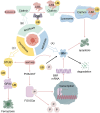The effect of ubiquitination and deubiquitination to imatinib resistance in gastrointestinal stromal tumors
- PMID: 40786504
- PMCID: PMC12331490
- DOI: 10.3389/fonc.2025.1581920
The effect of ubiquitination and deubiquitination to imatinib resistance in gastrointestinal stromal tumors
Abstract
Gastrointestinal stromal tumor (GIST) is the most common mesenchymal tumor. Imatinib, as a receptor-type tyrosine kinase inhibitor (TKI), becomes a first-line drug for adjuvant therapy and prognosis. However, patients are facing with the problem of primary and secondary drug resistance when using imatinib, which affects the effect of imatinib. Thus, it is particularly important to explore the mechanism of drug resistance. Ubiquitination and deubiquitination process have been proofed to performance as posttranslational modifications (PTMs) to influence the occurrence and progression of most tumors. Hence, we attach importance to these mechanisms and found that GIST resistance may be related to ubiquitination and deubiquitination in regulating exosome secretion, autophagy, apoptosis and ferroptosis. Through clarifying these connections, this review aims to offers insights and hope for therapeutic advancements of imatinib-resistant GIST patients and the use of specific ubiquitin modifications as markers in the future.
Keywords: deubiquitination modification; drug resistance; gastrointestinal stromal tumors; imatinib; ubiquitination modifications.
Copyright © 2025 Huo, Li, Yang, Wang, Zhao and Yang.
Conflict of interest statement
The authors declare that the research was conducted in the absence of any commercial or financial relationships that could be construed as a potential conflict of interest.
Figures



Similar articles
-
Imatinib for the treatment of patients with unresectable and/or metastatic gastrointestinal stromal tumours: systematic review and economic evaluation.Health Technol Assess. 2005 Jul;9(25):1-142. doi: 10.3310/hta9250. Health Technol Assess. 2005. PMID: 15985189
-
The Black Book of Psychotropic Dosing and Monitoring.Psychopharmacol Bull. 2024 Jul 8;54(3):8-59. Psychopharmacol Bull. 2024. PMID: 38993656 Free PMC article. Review.
-
Cost-effectiveness of using prognostic information to select women with breast cancer for adjuvant systemic therapy.Health Technol Assess. 2006 Sep;10(34):iii-iv, ix-xi, 1-204. doi: 10.3310/hta10340. Health Technol Assess. 2006. PMID: 16959170
-
Interpretable artificial intelligence to optimise use of imatinib after resection in patients with localised gastrointestinal stromal tumours: an observational cohort study.Lancet Oncol. 2024 Aug;25(8):1025-1037. doi: 10.1016/S1470-2045(24)00259-6. Epub 2024 Jul 5. Lancet Oncol. 2024. PMID: 38976997 Free PMC article.
-
Management of urinary stones by experts in stone disease (ESD 2025).Arch Ital Urol Androl. 2025 Jun 30;97(2):14085. doi: 10.4081/aiua.2025.14085. Epub 2025 Jun 30. Arch Ital Urol Androl. 2025. PMID: 40583613 Review.
References
Publication types
LinkOut - more resources
Full Text Sources
Miscellaneous

